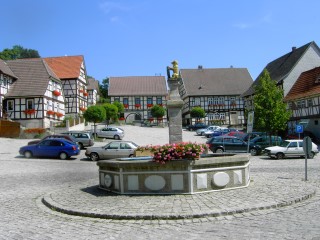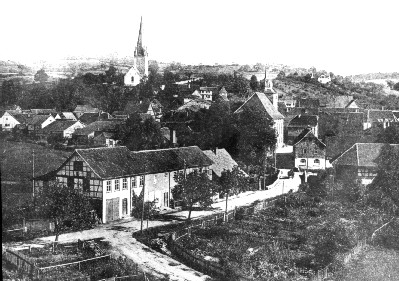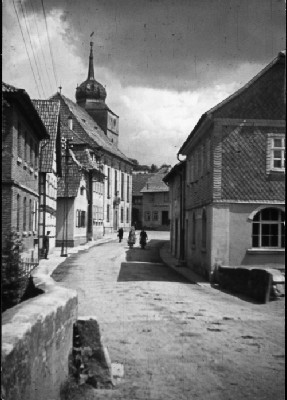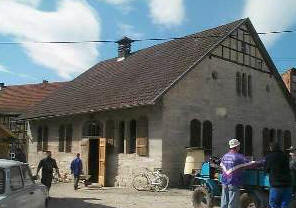
Ummerstadt
A. Surroundings
Welcome to Ummerstadt the smallest city in Thüringen and the the 2nd smallest city in Germany. Our 543 inhabitants are proud citizens of the “Heldburger Unterland” very close to the former east/west German border which is now called the Green Belt, which is also the state line between Bavaria and Thüringen. This area is also called the Franconian Hill Country, since it is naturally and historically influenced by Franconia, or the so-called “Franken” peoples. This you can also hear in the dialect that is spoken here and along the Rodach river, just below town.

Also in the building construction you the see the franconian influence. The timber houses are a post and beam construction which was the typical construction method in this area.
Ummerstadt belongs to the county of Hildburghausen, approximately 30 km north of here. Historically, Ummerstadt belonged to Sachsen, Coburg Gotha and since Coburg is only 12 km away, Ummerstadt was up to the Germany separation more oriented towards Coburg. Many people now work in Coburg again.
B. Town Hall
The town hall is the largest and most representative building of timber construction. In the basement carved into a sand stone wall, there is the date 1558 which is assumed to be the original building date of the town hall. In the 30 Year War – the exact year being 1632 – the building burned down as well as most of the other buildings in town. The pub on the 1st floor supposedly was still open, but everything else was gone. The town hall bell was brought to the lower town church for security reasons, but is now back in place and the oldest bell in town. In 1682 the town council (men) decided to build new on top of the old foundation. In the 18th century the building was completely stuccoed,

there are still pictures around that show the timber construction covered. In 1929 the stucco was removed as on most buildings in town. It became fashionable again to show the construction. The west side which faces the weather was enclosed with slate. The slate was removed in the year 2000, when the building was renovated again, but this is a real problem now…because rain is absorbed by the wooden beams and has makes the inner walls wet. The old craftsmen knew what they were doing. The pub downstairs and the city administration upstairs are still today in the same location.
C. Market Place.
Ummerstadt is also called the 5 fountain town. The fountains are spread throughout town and are fed by natural springs. The largest and most important fountain is the market fountain. On top you can see the Saxon lion with the coat of arms (tail) of Ummerstadt. They were used for drinking water for people and animals before the water lines were installed in 1929. On the upper end of the marketplace you can see the oldest surviving building, with the date of 1553 carved into the sandstone above the front door. To the right of this house is what we call the “Kaplanei”, or what was formerly the minister’s house. Today it houses our internet café which offers coffee and cake but also computer courses, and the office of “Initiative Rodachtal”, a group of 6 neighbouring communities which have pooled ideas and resources for the preservation and development of the surrounding region.

On the wooden sign of this house there is a historical mention of Konrad Müller also called “Müller von der Werra” whom was born here in 1828 and was a pharmacist and doctor. He was also the founder of the German singing club, wrote poems and lyrics and was supposedly an honorary guest at the opening of the Suez Canal. He also taught philosophy in Leipzig; a man of many talents, whom died in 1881. He was made an honorary citizen of Ummerstadt in 1937.
In 1998 the marketplace was completely remodelled. Until then there was a park at the upper end, at the lower end an area for parking and celebration. The center of town is part of the town development. The cobble stones are made of limestone, not granite, because this is a typical material of the area. Some people don’t like it too much, because the think it’s too hard to walk on. Especially for the older folks it is sometimes difficult. But having the slope is positive for the surrounding buildings which you really couldn’t see before.
The timber buildings are mainly from the time after the 30 years war. It is a wooden post and beam construction. In the plastered fields between the beams are willow tree branches with a clay/hey mixture to close the fields. The structure shows vertical, horizontal and diagonal beams, usually with no decoration, as you might find it in other areas. Some of the older buildings still show wooden nails, later they used metal handmade square nails made by blacksmiths, not the round formed nails we now use.
D. Andreas Kirche
The church dates back to the 6th to 8th century AD. It was supposed to be a monastery before the town existed. In the very early days they built on top of hills, later when there was no space left, the towns were build in valleys close to rivers for access to fresh water. In 1290 “Andreas Kirche” was first n church books with its own priest. At that time it was already a church, but was also used for protection of its citizens. It had high walls, twice as high as they are today. The tower existed we know in 1222, possibly earlier.

it belongs to a roman style architecture which is demonstrated my the massively thick walls, small windows and round arches. Later it got a high roof so that the tower was 46 meters high and was visible throughout the whole area. The tower was made into a prison; at the bottom you may still see a small room. Outside the walls they built two moats for defence and during the wars and dangerous times people assemble here for protection. They brought their animals and food to be safe. The cemetery came much later probably in the 18th century, probably because there was a shortage of space around the church down below. In 1934 the church was totally renovated, and at this time the stained glass was installed. A new floor was put in and the walls were painted. The outside walls were repaired. In 1945 at the end of the 2nd World War the church was bombed and completely destroyed, but for the stone walls. It was not reconstructed until 1960, and this is when it got the lower, 4 sided tent roof, as a reminder of its roman origin. Today, mainly funerals are taking place here. In the winter time, selected services are held here because there is no heating in our other church. And in the Andreas Kirche there is heating under the pews.
E. Heimat Museum – Local History Museum & Rectory
The museum displays historic objects from Ummerstadt and shows how people lived
And worked. Up until the 18th century our community was chief source of sustenance and income was through farming. All the necessary crafts were located here in town, like blacksmiths, brewers, tanners, textile mills, wool spinning, saddle makers and basket weavers. In the barn behind the museum the old spinning wheel is still there.
The craft which supported many people here in Ummerstadt was ceramics. The local craft dates back to the 16th century. The objects were painted and decorated to be sold. Also poetry and love notes were often inscribed on them, with the most renowned pottery poet being Heinrich Berghold. His pottery was sold all over Germany and made our town somewhat famous as a centre for the ceramics industry in the 1800’s. Most of the pieces you see in the museum are from the late 18th and 19th centuries. During this time Ummerstadt was called the pottery town and at its height there were approximately 50 pottery makers here, mainly located on Coburger Strasse. Many of the potters sold their wares at the markets in Coburg. Of course, industrialization squeezed the potters out of business, and the last potter closed his shop here in 1953. The clay pits were in Gemünda, the next town over (across the border of Thüringen in Bavaria) or in Bad Colberg, a little bit closer.
F. Town Church - St. Bartolomäus
The church dates back to the 15th century. You can see the tower which much older than the church. Over the side entry door cou can see in latin, the honouring of the Earl of Saxony who originally paid to have the church built.

In the 30 years war the building was completely destroyed and the church as you see it now was inaugurated on the 23rd of June 1748. The marble plate shows the only person that died in the war of 1870/71. Also the white marble plate is a memento of the same era. The interior of the church is in the baroque style, a renovation in 1892 connected the altar space and the pulpit. The center stone of the triumph arch show the letters EFC the initials of the governing duke Ernst Friedrich Carl III. The inscription “Ehre sei Gott in der Höhe” meaning “Honor to God the almighty” was removed during the renovation of the church in 1990. The wooden painted angel is from the 18th Century and still used for baptisms. The organ also from the 18th century was built by Johann Christian Dotzauer from Hildburghausen. Before the 18th Century the cemetery surrounded the church.
G. Brewery
Ummerstadt even until today keeps up the tradition of brewing beer. Twice a year the doors of the community brewery are opened to its citizens. The sandstone building is from the year 1861 and replaced a brewery which was somewhat smaller. A second brewery was located at the bridge in the direction of Lindenau, which is now used as a construction storage room by the city.

The building has its original look, nothing has been changed since the original construction. If you have a chance to be here when they are brewing take a look inside. It’s quite impressive to step back 150 years into the past.
The brewery has the capacity to brew 2500 liters of beer per day. The same spring water which feeds the fountains is also used to make the beer. The beer is dark, with an herbal and somewhat dry aftertaste. Its strong taste comes from the large amount of hops used in brewing the beer. In the old days, a larger amount of hops was used to make the beer so that it would keep longer and not become sour so quickly. After the brewing, the barrels are stored in the near by stone and rock cellars in the direction of Weitramsdorf/Coburg. As a side note, the brewery is run by the brewing club, which is the largest club in town with almost 500 members (of course not all Ummerstadters).
Chronological History of Ummerstadt, Germany (State of Thueringen)
800 Monastery and St. Andreas church built.
837 Ummerstadt first mentioned under the name “Undrungen novu morcru” meaning surrounded by forests.
1223 “Ummerstat” first appears when Earl Asis gives Ummerstadt to the monastery of Fulda.
1242 The Count (Graf) of Henneberg sends an administrator to Ummerstadt and the beginning of the urban structure of town walls…1319.
1394 Ummerstadt receives city rights, which means there was a market held each week (it still exists: Thursday mornings).
1431 First mayor and town council installed.
1528 Beginning of Reformation and the first German-Latin school. The recent film “Luther” was partially shot on the market place in Ummerstadt as well surrounding area.
1618 At the beginning of the 30 Year War Ummerstadt has 775 inhabitants. During the 30 Year War all public buildings and 52 houses burned to the ground.
1634-54 First church remodelled.
1682 Today’s town hall rebuilt.
1748 Today’s church inaugurated.
1861 Community brewery built.
1906 First telephone line to Coburg.
1921 Water supply system.
1922 Electricity.
1937 1100 year celebration.
1945 St. Andreas Church bombed in World War II
1953 Border closed.
1980-1990 Rennovation of the town church.
1982 Erlebach was torn down.
1989 End of the cold war.
1990 Reunion of Germany
1994 600 years of city right.
2004 Kindergarten renovated